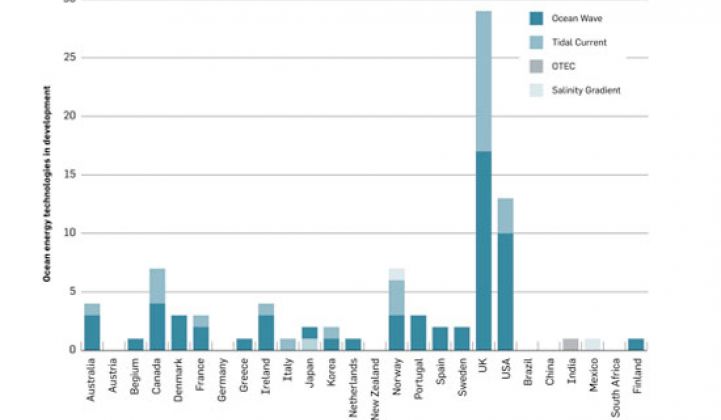The emerging ocean power industry is poised to grow from less than 10 megawatts of capacity worldwide today to more than 1 gigawatt in six years, reaching a market worth more than $500 million annually, according to a report by Greentech Media and the Prometheus Institute scheduled for publication next week.
The report, "Forecasting the Future of Ocean Power," offers a comprehensive look at the technologies, players and market outlook for an industry that is currently dominated by developments in the United Kingdom, the United States, Canada, Norway, Ireland and Australia (see report summary).
In six years, more than $2 billion will be invested to build commercial ocean wave power farms and another $2 billion will go towards research and development globally, said report co-authors Daniel Englander and Travis Bradford. Englander is a Greentech Media analyst while Bradford is the president of the Prometheus Institute.
The concept of using waves and tides to generate electrical power isn't new. The first patent for an ocean power device was filed in France in the 18th century, while wave motor designs were pursued in the California during the 19th and 20th centuries. However, researchers and entrepreneurs truly dived into the field in the mid-1970s and early 1980s, when the oil crisis spurred some renewable energy developments.
The current push for clean energy has renewed interest in ocean power projects, and most of the current designs originated in the late 1990s and early 2000s.
The industry's 35 most active companies have received just over $500 million in investments since 2001, the report said. The money has come from a variety of sources, including venture capital, loans and certain types of government funding.
Only a handful of companies have reported revenues, however. And the industry faces tough challenges in engineering, installing and operating equipment that can generate power at attractive prices.
Ocean energy resources are abundant and reliable, while the size and energy content of waves can be predicted from three to five days in advance. The currents and tides, in fact, are 832 times denser than the air that drives wind turbines.
The ocean power industry has another key advantage that other renewable energy sectors don't have. It can shorten the time needed for research and development by re-engineering proven technologies from the offshore oil and gas, wind power and shipbuilding industries.
"Technology transfer between traditional marine and wind industries and the ocean power industry has allowed many companies to move rapidly into advanced research and development," wrote Englander and Bradford. "As such, the development bottleneck in ocean power often occurs in the scaling-up stage and not the device design stage."
The United Kingdom, the United States, Australia and Ireland are among the top ocean power project developers in the world, according to the International Energy Association. In 2006, the association identified 81 projects – from university and government-led research to private industry initiatives (see chart below).
The report examines three sectors of the ocean power industry: wave power, tidal power and fixing technologies. Fixing technologies refers to equipment that stabilizes or otherwise enhances the performance of an ocean power park.
Wave power has captured more attention than tidal power, thanks to its availability over a wide swath of area. Of the 35 companies examined in the report, 24 of them are harnessing wave energy.
Most of the wave power companies are developing point absorbers, which look like giant buoys and are able to use energy from waves from all directions to drive power generators. Companies dissected in the report include AWS Ocean Energy, Wave Dragon, Oceanlinx, Pelamis Wave Power and Finavera Renewables.
Finavera Renewables, in Vancouver, Canada, signed a contract with the Pacific Gas and Electric Co. in California last year to sell 4-gigawatt-hours of electricity annually from a project off the coast in Eureka, Calif. (see Wave Energy Finds a Buyer).
With the possible exception of geothermal power, tidal power is the most reliable source of energy, thanks to its predicable changes affected by lunar phases, the report said.
Tidal power companies have been building their know-how based on wind energy technologies. Most of the tidal power companies are developing horizontal axis turbines. But tidal power turbines can generate more power at smaller sizes. In fact, a 1-megawatt tidal turbine can be up to one-third smaller than a 1-megawatt wind turbine.
Tidal power companies examined in the report include SMD Hydrovision, Marine Current Turbines, Open Hydro and Ocean Renewable Power.
In May, Marine Current Turbines said it had installed what it said was the world's largest, 1.2-megawatt tidal turbine (see Tide Turning for Ocean Power?).
Greentech Media will present a two-day ocean power conference in Portland, Ore. starting on Feb. 10, 2009.



